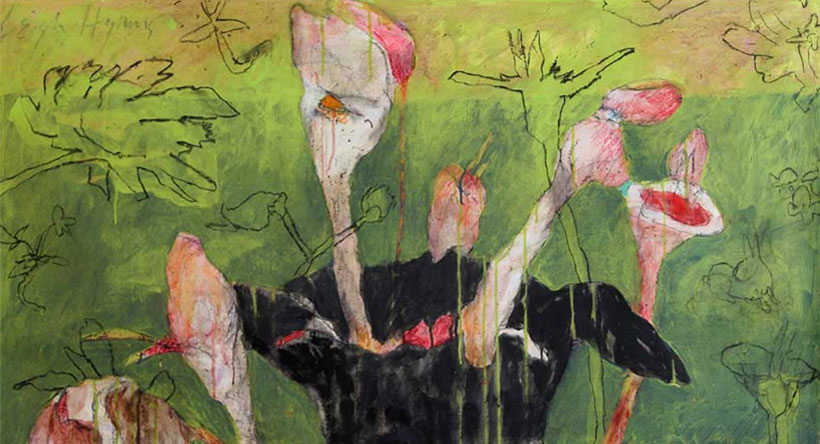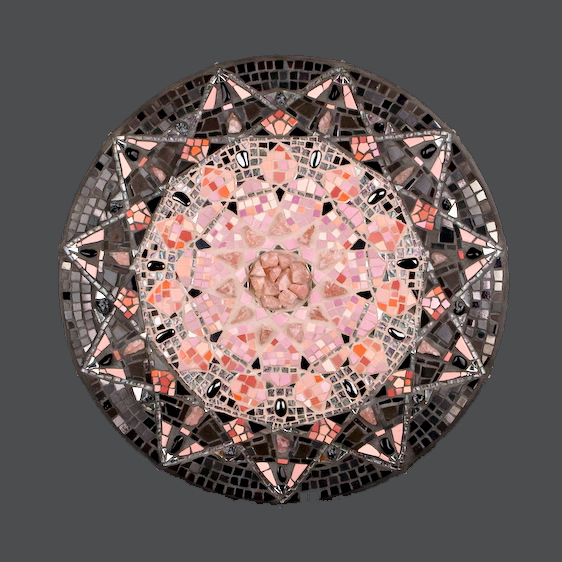Leigh Hyams served as Founding Executive Director of the Djerassi Resident Artists Project in Woodside, California. Ms. Hyams passed away at age 86 on March 12, 2013 in San Miguel Allende, Mexico, the same day that the first group of artists for the season arrived at SMIP Ranch back in the late 70s. Her writings are filled with wisdom, and for teaching artist readers and mosaic compadres who may be new to the mechanics of art critique, I want to share this find:
A useful and clear outline for conducting a productive art critique.
See more of Leigh Hyam’s work at artsreal.com.
Her memorial page is here https://www.facebook.com/LeighHyamsMemorial
Her obituary and many photos of her formidable career may be found at
https://www.facebook.com/notes/leigh-hyams-memorial/leigh-hyams/137965173041025.
GUIDE TO A GOOD DRAWING and PAINTING CRITIQUE
by Leigh HyamsThe group understands and agrees that you are there to learn from each other and each other’s work. You do not learn from a“Show and Tell” attitude, nor do you hesitate to give your honest opinion because you might hurt someone’s feelings. Don’t “take care” of each other. You are serious working artists trying to become better artists, period.
Any number of artists can be in a crit group though 8 or 10 are usually the maximum because of time and space constraints. A leader is not essential.
MECHANICS
Choose a definite time and place to meet regularly—twice a month? Once a month make an agreement to stick to the arrangement for a six-month trial period to start. If your house burns down and you can’t come to a meeting, you are responsible for finding a (suitable) substitute artist to take your place for that session. Keep the group together and firmly committed for the six months, no matter what.
Always start on time and skip the coffee and cookies. Think like serious artists right from the start. It’s friendly and informal but it is a working session and you are there to learn from each other and each other’s work.
A two-hour session is usually best. Divide the number of members into 120 minutes so people are assured equal time for discussion of their work. (i.e. ten members= twelve minutes each). Appoint a timekeeper or use a simple kitchen timer as a reminder.
Use as much of your personal time period as you choose—showing and discussing with the group your old or new work, unfinished work, and/or discuss studio, galleries, museums or art material problems. If you feel you have no work to bring in, come anyway. NO excuses. You will be nourished and validated as an artist just by being there.
Baudelaire, 27″ x 49″ hibiscus, charcoal and acrylic on canvas 2006, by Leigh Hyam, photo: artsreal.com
PROCEDURE
Whomever wants to begin places work in front of the group—on the wall or leaning against it depending on the facility. Pay attention to placement. Leave enough space between each piece, be sure they’re not crooked, etc. so they’re presented respectfully and well for discussion.
It’s important for each group member to verbally express his or her opinion. The learning goes deeper that way. Complete honesty is necessary and everyone’s opinion is valid. An opinion is an opinion, nothing else. If they contradict each other, great! Further conversation about the differences is usually stimulating and informative.
Remind yourselves periodically that you are discussing the specific work itself, not the character of the artist who made it. If there are negative comments about your work, listen to them openly, ask questions of the speaker to clarify things if you want, think about them. You may find the comments helpful or a pain in the neck, or they may give you a wonderful new idea. Comments are opinions to listen to and consider. You are not obliged to act on them.
DISCUSSION PARAMETERS
When an artist places work in front of the group, take a quiet moment to “enter” it. Let your eyes travel around individual paintings and be aware that the rest of your body is also sensing, perceiving and experiencing the work.
One way to start is to say “How does this painting make you feel?” “It makes me feel excited/boredhappyconfused/apprehensive”. Then discuss what it is in the painting itself (excluding any subject matter depicted) that causes you to have that particular feeling. Is it the artist’s choice of color? Turbulent brush strokes? etc.
Don’t “read” a painting like a book, don’t “de-code” the images presented and tell the group what they remind you of. Explanations or stories in words that the subject matter reminds you of may be interesting in themselves but they are irrelevant in a critique. We are only concerned with the actual painting itself, the VISUAL language in which it is speaking—how the artist is handling the relationship of color, line and space, its movement on the 2 dimensional ground, its rhythms, texture, line quality, and how they relate to the expressiveness of the images being painted.
If your attention is drawn to a certain area that doesn’t feel resolved, say to the group “That orange spot in the lower right bothers me”. Ask the person to state WHY it bothers them. “I don’t like the color..” What color would you suggest? Where would you put it?
Leigh with mentor Philip Guston, 1965.
Pay particular attention to the relationship of shapes, their values (darkness or lightness), to color qualities (intense, dull, transparent, opaque) and to their emotional power. Note how color moves in a painting, and how it has been applied to the paper or canvas. Is the “skin” of the painting interesting or is it all the same? Is it thick? thin layers? applied with the same density and the same brush strokes? same rhythm? Is more texture needed? Did the artist use a single brush for the entire painting? Does it need more variation? Does the canvas breathe?
And always notice how different elements in the painting appear to exist on different spacial planes, how space moves in and out, and across the picture plane. Discuss how the artist made that happen on a flat piece of paper or canvas. Does the painting have deep space, shallow space? Is it flat, dead and unmoving? If so, what could be done about it? And always, is the passion and committment of the artist sustained throughout the painting?
SUMMARY
Whatever comments are made about individual works, positive or negative, try to state your opinion fearlessly and clearly, and then explain what it is in the painting that makes you feel that way. Make suggestions for change if you have some. Comment on what you like as well as dislike about individual works and again, explain WHY. Don’t hesitate to make suggestions for future work an individual artist could pursue but don’t take it personally if the artist doesn’t do it.
Realize that you are learning a new language and know that each critique you take part in is educating you, sharpening your perception, and opening new possibilities to explore in your work. It’s a facinating ongoing process and as your understanding of visual language deepens, you deepen as an artist and so does your work.
HONOR OUR ELDERS







Wow, I can see how valuable this can be in growing as artists. What a great idea!
yes! having guidelines for critique keep it from getting personal. less coffee klatch and more, as you say, about growing as an artist. Thanks Randi!
What a good idea – it has made me think about setting a small group up with some friends…Thank you Lillian (e Buona Pasqua!)